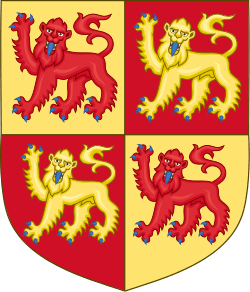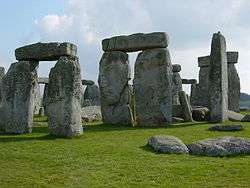Wales in the Early Middle Ages
Wales in the early Middle Ages covers the time between the Roman departure from Wales c. 383 and the rise of Merfyn Frych to the throne of Gwynedd c. 825. In that time there was a gradual consolidation of power into increasingly hierarchical kingdoms. The end of the early Middle Ages was the time that the Welsh language transitioned from the Primitive Welsh spoken throughout the era into Old Welsh, and the time when the modern England–Wales border would take its near-final form, a line broadly followed by Offa's Dyke, a late eighth-century earthwork. Successful unification into something recognisable as a Welsh state would come in the next era under the descendants of Merfyn Frych.

Part of a series on the |
|---|
| History of Wales |
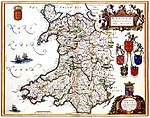 |
|
Chronology |
|
|
Wales was rural throughout the era, characterised by small settlements called trefi. The local landscape was controlled by a local aristocracy and ruled by a warrior aristocrat. Control was exerted over a piece of land and, by extension, over the people who lived on that land. Many of the people were tenant peasants or slaves, answerable to the aristocrat who controlled the land on which they lived. There was no sense of a coherent tribe of people and everyone, from ruler down to slave, was defined in terms of his or her kindred family (the tud) and individual status (braint). Christianity had been introduced in the Roman era, and the Celtic Britons living in and near Wales were Christian throughout the era.
The semi-legendary founding of Gwynedd in the fifth century was followed by internecine warfare in Wales and with the kindred Brittonic kingdoms of northern England and southern Scotland (the Hen Ogledd) and structural and linguistic divergence from the southwestern peninsula British kingdom of Dumnonia known to the Welsh as Cernyw prior to its eventual absorption into Wessex. The seventh and eighth centuries were characterised by ongoing warfare by the northern and eastern Welsh kingdoms against the intruding Anglo-Saxon kingdoms of Northumbria and Mercia. That era of struggle saw the Welsh adopt their modern name for themselves, Cymry, meaning "fellow countrymen", and it also saw the demise of all but one of the kindred kingdoms of northern England and southern Scotland at the hands of then-ascendant Northumbria.
Geography
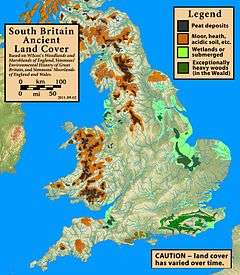
The total area of Wales is 20,779 km2 (8,023 sq mi),[1] or 9% of the area of Great Britain. Much of the landscape is mountainous with treeless moors and heath, and having large areas with peat deposits. There is approximately 1,200 km (746 mi) of coastline[2] and some 50 offshore islands, the largest of which is Anglesey. The present climate is wet and maritime, with warm summers and mild winters,[3] much like the later medieval climate, though there was a significant change to cooler and much wetter conditions in the early part of the era.[4][note 1] The southeastern coast was originally a wetland, but reclamation has been ongoing since the Roman era.
There are deposits of gold, copper, lead, silver and zinc, and these have been exploited since the Iron Age, especially so in the Roman era.[5] In the Roman era some granite was quarried, as was slate in the north and sandstone in the east and south.[6]
Native fauna included large and small mammals, such as the brown bear, wolf, wildcat, rodents, several species of weasel, and shrews, voles and many species of bat. There were many species of birds, fish and shellfish.
The early medieval human population has always been considered relatively low in comparison to England, but efforts to reliably quantify it have yet to provide widely acceptable results.[7]
Subsistence
Much of the arable land is in the south, southeast, southwest, on Anglesey, and along the coast. However, specifying the ancient usage of land is problematic in that there is little surviving evidence on which to base the estimates. Forest clearance has taken place since the Iron Age, and it is not known how the ancient people of Wales determined the best use of the land for their particular circumstances,[8] such as in their preference for wheat, oats, rye or barley depending on rainfall, growing season, temperature and the characteristics of the land on which they lived. Anglesey is the exception, historically producing more grain than any other part of Wales.[9]
Animal husbandry included the raising of cattle, pigs, sheep and a lesser number of goats. Oxen were kept for ploughing, asses for beasts of burden and horses for human transport.[10] The importance of sheep was less than in later centuries, as their extensive grazing in the uplands did not begin until the thirteenth century.[11] The animals were tended by swineherds and herdsmen, but they were not confined, even in the lowlands. Instead open land was used for feeding, and seasonal transhumance was practiced. In addition, bees were kept for the production of honey.[12]
Society
Kindred family
The importance of blood relationships, particularly in relation to birth and noble descent, was heavily stressed in medieval Wales.[13] Claims of dynastic legitimacy rested on it, and an extensive patrilinear genealogy was used to assess fines and penalties under Welsh law. Different degrees of blood relationship were important for different circumstances, all based upon the cenedl (kindred). The nuclear family (parents and children) was especially important, while the pencenedl (head of the family within four patrilinear generations) held special status, representing the family in transactions and having certain unique privileges under the law. Under extraordinary circumstances the genealogical interest could be stretched quite far: for the serious matter of homicide, all of the fifth cousins of a kindred (the seventh generation: the patrilinear descendants of a common great-great-great-great-grandfather) were ultimately liable for satisfying any penalty.[14]
Land and political entities
The Welsh referred to themselves in terms of their territory and not in the sense of a tribe. Thus there was Gwenhwys ("Gwent" with a group-identifying suffix) and gwyr Guenti ("men of Gwent") and Broceniauc ("men of Brycheiniog"). Welsh custom contrasted with many Irish and Anglo-Saxon contexts, where the territory was named for the people living there (Connaught for the Connachta, Essex for the East Saxons). This is aside from the origin of a territory's name, such as in the custom of attributing it to an eponymous founder (Glywysing for Glywys, Ceredigion for Ceredig).[15]
The Welsh term for a political entity was gwlad ("country") and it expressed the notion of a "sphere of rule" with a territorial component. The Latin equivalent seems to be regnum, which referred to the "changeable, expandable, contractable sphere of any ruler's power".[16] Rule tended to be defined in relation to a territory that might be held and protected, or expanded or contracted, though the territories themselves were specific pieces of land and not synonyms for the gwlad.
Throughout the Middle Ages the Welsh used a variety of words for rulers, with the specific words used varying over time, and with literary sources generally using different terms than annalistic ones. Latin language texts used Latin language terms while vernacular texts used Welsh terms. Not only did the specific terms vary, the meaning of those specific terms varied over time as well.[17] For example, brenin was one of the terms used for a king in the twelfth century. The earlier, original meaning of brenin was simply a person of status.[18]
Kings are sometimes described as overkings, but the definition of what that meant is unclear, whether referring to a king with definite powers, or to ideas of someone considered to have high status.[19]
Kingship
Wales in the early Middle Ages was a society with a landed warrior aristocracy,[20] and after c. 500 Welsh politics were dominated by kings with territorial kingdoms.[21] The legitimacy of the kingship was of paramount importance,[22] the legitimate attainment of power was by dynastic inheritance or military proficiency.[23] A king had to be considered effective and be associated with wealth, either his own or by distributing it to others,[24] and those considered to be at the top level were required to have wisdom, perfection, and a long reach.[25] Literary sources stressed martial qualities such as military capability, bold horsemanship, leadership, the ability to extend boundaries and to make conquests, along with an association with wealth and generosity. Clerical sources stressed obligations such as respect for Christian principles, providing defence and protection, pursuing thieves and imprisoning offenders, persecuting evildoers, and making judgements.[26]
The relationship among people that is most appropriate to the warrior aristocracy is clientship and flexibility, and not one of sovereignty or absolute power, nor necessarily of long duration.[27] Prior to the tenth century power was held on a local level,[28] and the limits of that power varied by region.[29] There were at least two restraints on the limits of power: the combined will of the ruler's people (his "subjects"), and the authority of the Christian church.[30] There is little to explain the meaning of "subject" beyond noting that those under a ruler owed an assessment (effectively, taxes) and military service when demanded, while they were owed protection by the ruler.[31]
Kings
For much of the early medieval period kings had few functions except military ones. Kings made war and gave judgements (in consultation with local elders)[30] but they did not govern in any sense of that word.[32] From the sixth to the eleventh centuries the king moved about with an armed, mounted warband,[33] a personal military retinue called a teulu that is described as a "small, swift-moving, and close-knit group".[34] This military elite formed the core of any larger army that might be assembled. The relationships among the king and the members of his warband were personal, and the practice of fosterage strengthened those personal bonds.[35]
Aristocracy
Power was held at a local level by families who controlled the land and the people who lived on that land. They are differentiated legally by having a higher sarhaed (the penalty for insult) than the general populace, by the records of their transactions (such as land transfers)[36] by their participation in local judgements and administration,[37] and by their consultative role in judgements made by the king.[30]
References to the social stratification that defines an aristocracy are widely found in Welsh literature and law. A man's privilege was assessed in terms of his braint (status), of which there were two kinds (birth and office), and in terms of his superior's importance. Two men might each be an uchelwr (high man), but a king is higher than a breyr (a regional leader), so legal compensation for the loss to a king's bondsman (aillt) was higher than the equivalent loss to the bondsman of a breyr. Early sources stressed birth and function as the determinators of nobility, and not by the factor of wealth that later became associated with an aristocracy.[38]
Populace
The populace included a hereditary tenant peasantry who were not slaves or serfs, but were less than free.[39] Gwas ("servant", boy) referred to a dependent in perpetual servitude, but who was not bound to labour service (i.e., serfdom). Nor can the person be considered a vassal except perhaps as a clerical self-description, as in the 'vassal of a saint'. The early existence of the concept suggests a stratum of bound dependents in the post-Roman era.[40] The proportion of the medieval population that consisted of freemen or free peasant proprietors is undetermined, even for the pre-Conquest period.[41]
Slavery existed in Wales as it did elsewhere throughout the era.[42] Slaves were in the bottom stratum of society, with hereditary slavery more common than penal slavery. Slaves might form part of the payment in a transaction made between those of higher rank. It was possible for them to buy their freedom, and an example of manumission at Llandeilo Fawr is given in a ninth-century marginalia note of the Lichfield Gospels.[43] Their relative numbers is a matter of guess and conjecture.[44]
Christianity
The religious culture of Wales was overwhelmingly Christian in the early Middle Ages.[45] Pastoral care of the laity was necessarily rural in Wales, as it was in other Celtic regions.[46] In Wales the clergy consisted of monks, orders and non-monastic clergy, all appearing in different periods and in different contexts. There were three major orders consisting of bishops (episcopi), priests (presbyteri) and deacons, as well as several minor ones. Bishops had some temporal authority, but not necessarily in the sense of a full diocese.[47]
Communities
Monasticism is known in Britain in the fifth century though its origins are obscure. The Church seemed episcopally dominated and largely consisting of monasteries. The size of the religious communities is unknown (Bede and the Welsh Triads suggest they were large, the Lives of the Saints suggest they were small, but these are not considered credible sources on the matter).[48] The different communities were pre-eminent within small spheres of influence (ie, within physical proximity of the communities).[49] The known sites are mostly coastal, situated on good land.[50] There are passing references to monks and monasteries in the sixth century (for example, Gildas said that Maelgwn Gwynedd had originally intended to be a monk). From the seventh century onward there are few references to monks but more frequent references to 'disciples'.[51]
Institutions
Archaeological evidence consists partly of the ruined remains of institutions, and in finds of inscriptions and the long cyst burials that are characteristic of post-Roman Christian Britons.
These long cyst burials occur in the southern Scottish lowlands, Wales, and the West Country of England. The grave is lined with stones, there are no grave goods, they often have an east-west orientation, and they date from a time before churches were commonly attached to cemeteries. They contrast with Anglo-Saxon burials, which followed a different inhumation custom.[52]
The records of transactions and legal references provide information on the status of the clergy and its institutions. Landed proprietorship was the basis of support and income for all clerical communities, exploiting agriculture (crops), herding (sheep, pigs, goats), infrastructure (barns, threshing floors), and employing stewards to supervise the labour. Lands that were not adjacent to the communities provided income in the form of (in effect) a business of landlordship.[53] Lands under clerical proprietorship were exempt from the fiscal demands of kings and secular lords. They had the power of nawdd (protection, as from legal process) and were noddfa (a "nawdd place" or sanctuary).[54] Clerical power was moral and spiritual, and this was sufficient to enforce recognition of their status and to demand compensation for any infringement on their rights and privileges.[55]
History
Saints
Bede's Ecclesiastical History
The notion of a separate Anglo-Saxon and British approach to Christianity dates back at least to Bede. He portrayed the Synod of Whitby (in 664) as a set-piece battle between competing Celtic and Roman religious interests.[56] While the synod was an important event in the history of England and brought finality to several issues in Anglo-Saxon Britain, Bede probably overemphasised its significance so as to stress the unity of the English Church.[57]
Bede's characterisation of Saint Augustine's meeting with seven British bishops and the monks of Bangor Is Coed (in 602–604) portrays the bishop of Canterbury as chosen by Rome to lead in Britain, while portraying the British clergy as being in opposition to Rome. He then adds a prophecy that the British church would be destroyed.[58] His apocryphal prophecy of destruction is quickly fulfilled by the massacre of the Christian monks at Bangor Is Coed by the Northumbrians (c. 615), shortly after the meeting with Saint Augustine. Bede describes the massacre immediately following his delivery of the prophecy.[59]
'Celtic' vs. 'Roman' myth
One consequence of the Protestant Reformation and subsequent ethnic and religious discord in Britain and Ireland was the promotion of the idea of a 'Celtic' church that was different from and at odds with the 'Roman' church, and that held to certain offensive customs, especially in the dating of Easter, the tonsure, and the liturgy. Scholars have noted the partisan motives and inaccuracy of the characterisation,[60][61][62] as has The Catholic Encyclopedia, which also explains that the Britons using the 'Celtic Rite' in the early Middle Ages were in communion with Rome.[63][64]
Cymry
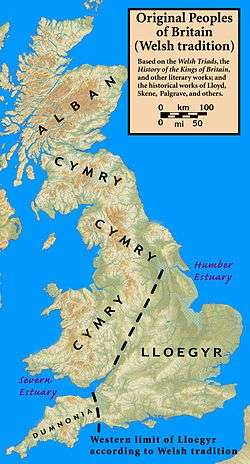
The early Middle Ages saw the creation and adoption of the modern Welsh name for themselves, Cymry, a word descended from Common Brittonic combrogi, meaning "fellow-countrymen".[65][66] It appears in Moliant Cadwallon (In Praise of Cadwallon), a poem written by Cadwallon ap Cadfan's bard Afan Ferddig c. 633,[67] and probably came into use a self-description before the seventh century.[68] Historically the word applies to both the Welsh and the Brythonic-speaking peoples of northern England and southern Scotland, the peoples of the Hen Ogledd, and emphasises a perception that the Welsh and the "Men of the North" were one people, exclusive of all others. Universal acceptance of the term as the preferred written one came slowly in Wales, eventually supplanting the earlier Brython or Brittones.[69] The term was not applied to the Cornish people or the Bretons, who share a similar heritage, culture and language with the Welsh and the Men of the North.[70] Rhys adds that the Bretons sometimes give the simple brô the sense of compatriot.
All of the Cymry shared a similar language, culture and heritage. Their histories are stories of warrior kings waging war, and they are intertwined in a way that is independent of physical location, in no way dissimilar to the way that the histories of neighboring Gwynedd and Powys are intertwined. Kings of Gwynedd campaigned against Brythonic opponents in the north.[71] Sometimes the kings of different kingdoms acted in concert, as is told in the literary Y Gododdin. Much of the early Welsh poetry and literature was written in the Old North by northern Cymry.
All of the northern kingdoms and people were eventually absorbed into the kingdoms of England and Scotland, and their histories are now mostly a footnote in the histories of those later kingdoms, though vestiges of the Cymry past are occasionally visible. In Scotland the fragmentary remains of the Laws of the Bretts and Scotts show Brythonic influence, and some of these were copied into the Regiam Majestatem, the oldest surviving written digest of Scots law, where can be found the 'galnes' (galanas) that is familiar to Welsh law.[72]
History
Irish settlement
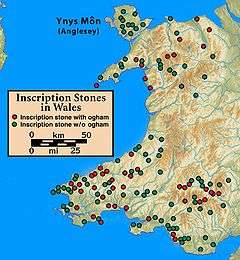
In the late fourth century there was an influx of settlers from southern Ireland, the Uí Liatháin and Laigin (with Déisi participation uncertain),[73][74][75][76] arriving under unknown circumstances but leaving a lasting legacy especially in Dyfed. It is possible that they were invited to settle by the Welsh. There is no evidence of warfare, a bilingual regional heritage suggests peaceful coexistence and intermingling, and the Historia Brittonum written c. 828 notes that a Welsh king had the power to settle foreigners and transfer tracts of land to them.[77] That Roman-era regional rulers were able to exert such power is suggested by the Roman tolerance of native hill forts where there was local leadership under local law and custom.[78] Whatever the circumstances, there is nothing known to connect these settlers either to Roman policy, or to the Irish raiders (the Scoti) of classical Roman accounts.
Roman-era legacy
Forts and roads are the most visible physical signs of a past Roman presence, along with the coins and Roman-era Latin inscriptions that are associated with Roman military sites.[79] There is a legacy of Romanisation along the coast of southeastern Wales. In that region are found the remains of villas in the countryside. Caerwent and three small urban sites, along with Carmarthen and Roman Monmouth, are the only "urbanised" Roman sites in Wales.[80] This region was placed under Roman civil administration (civitates) in the mid-second century, with the rest of Wales being under military administration throughout the Roman era.[81] There are a number of borrowings from the Latin lexicon into Welsh, and while there are Latin-derived words with legal meaning in popular usage such as pobl ("people"), the technical words and concepts used in describing Welsh law in the Middle Ages are native Welsh, and not of Roman origin.[82]
There is ongoing debate as to the extent of a lasting Roman influence being applicable to the early Middle Ages in Wales, and while the conclusions about Welsh history are important, Wendy Davies has questioned the relevance of the debates themselves by noting that whatever Roman provincial administration might have survived in places, it eventually became a new system appropriate to the time and place, and not a "hangover of archaic practices".[83]
Earliest kingdoms
The exact origins and extent of the early kingdoms are speculative. The conjectured minor kings of the sixth century held small areas within a radius of perhaps 24 km (15 mi), probably near the coast. Throughout the era there was dynastic strengthening in some areas while new kingdoms emerged and then disappeared in others.[84] There is no reason to suppose that every part of Wales was part of kingdom even as late as 700.[85]
Dyfed is the same land of the Demetae shown on Ptolemy's map c. 150 during the Roman era. The fourth century arrival of Irish settlers intertwined the royal genealogies of Wales and Ireland, with Dyfed's rulers appearing in The Expulsion of the Déisi,[86] Harleian MS. 5389[87] and Jesus College MS. 20.[88] Its king Vortiporius was one of the kings condemned by Gildas in his De Excidio et Conquestu Britanniae, c. 540.[89] [90]
While the better documented southeast shows a long and slow acquisition of property and power by the dynasty of Meurig ap Tewdrig in connection with the kingdoms of Glywysing, Gwent and Ergyng, there is a near-complete absence of information about many other areas. The earliest known name of a king of Ceredigion was Cereticiaun, who died in 807, and none of the mid-Welsh kingdoms can be evidenced before the eighth century. There are mentions of Brycheiniog and Gwrtheyrnion (near Buellt) in that era, but for the latter it is difficult to say whether it had either an earlier or a later existence.[91]
The early history in the north and east are somewhat better known, with Gwynedd having a semi-legendary origin in the arrival of Cunedda from Manau Gododdin in the fifth century (an inscribed sixth century gravestone records the earliest known mention of the kingdom).[92] Its king Maelgwn Gwynedd was one of the kings condemned by Gildas in his De Excidio et Conquestu Britanniae, c. 540.[89][90] There may also have been sixth-century kingdoms in Rhos, Meirionydd and Dunoding, all associated with Gwynedd.[93]
The name of Powys is not certainly used before the ninth century, but its earlier existence (perhaps under a different name) is reasonably inferred by the fact that Selyf ap Cynan (d. 616) and his grandfather are in the Harleian genealogies as the family of the known later kings of Powys, and Selyf's father Cynan ap Brochwel appears in poems attributed to Taliesen, where he is described as leading successful raids throughout Wales.[91] Seventh-century Pengwern is associated with the later Powys through the poems of Canu Heledd, which name sites from Shropshire to Dogfeiling to Newtown in lamenting the demise of Pengwern's king Cynddylan;[94] but the poem's geography probably reflects the time of its composition, around the ninth or tenth century rather that Cynddylan's own time.[95]
Seventh century
Eighth century
Literature
See also
- Matter of Britain
- Historical basis for King Arthur
- Medieval Welsh literature
Notes
- The same change in climate was occurring around the entire North Sea perphery at this time. See Higham's Rome, Britain and the Anglo-Saxons (ISBN 1-85264-022-7, 1992): cooler, wetter climate and abandonment of British uplands and marginal lands; Berglund's Human impact and climate changes—synchronous events and a causal link? in "Quaternary International", Vol. 105 (2003): Scandinavia, 500AD wetter and rapidly cooling climate and the retreat of agriculture; Ejstrud's The Migration Period, Southern Denmark and the North Sea (ISBN 978-87-992214-1-7, 2008): p28, from the 6th century onwards farmlands in Denmark and Norway were abandoned; Issar's Climate changes during the holocene and their impact on Hydrological systems (ISBN 978-0-511-06118-9, 2003): water level rise along NW coast of Europe, wetter conditions in Scandinavia and retreat of farming in Norway after 400, cooler climate in Scotland; Louwe Kooijmans' Archaeology and Coastal Change in the Netherlands (in Archaeology and Coastal Change, 1980): rising water levels along the NW coast of Europe; Louwe Kooijmans' The Rhine/Meuse Delta (PhD thesis, 1974): rising water levels along the NW coast of Europe, and in the Fens and Humber Estuary. Abundant material from other sources portrays the same information.
Citations
- "England and Wales". European Land Information Service. Retrieved 2 October 2010.
- "Review and evaluation of heritage coasts in England" (PDF). Countryside Agency. naturalengland.org.uk. 10 February 2012.
- "Met Office: Regional Climate: Wales". Met Office website. Met Office. 2010. Retrieved 26 September 2010.
- Davies 1982:5–9, Wales in the Early Middle Ages", "Land, Landscape and Environment".
- Jones 1990:179–195, Atlas of Roman Britain, "The Economy".
- Jones 1990:219, Atlas of Roman Britain
- Davies 2009:XVIII:214, Looking backwards to the early medieval past: Wales and England, a contrast in approaches (2004).
- Jones 1990:1–15, Atlas of Roman Britain, "The Physical Context".
- Davies 1982:5–12, Wales in the Early Middle Ages, "Land, Landscape and Environment".
- Davies 1982:39, Wales in the Early Middle Ages, "Economy".
- Davies 1982:11, Wales in the Early Middle Ages, "Land, Landscape and Environment".
- Davies 1982:39–41, Wales in the Early Middle Ages, "Economy".
- Davies 1982:63, Wales in the Early Middle Ages.
- Davies 1982:71–72, Wales in the Early Middle Ages.
- Davies 1989:19–20, Patterns of Power in Early Wales.
- Davies 1989:17, Patterns of Power in Early Wales.
- Davies 1989:10–15, Patterns of Power in Early Wales, Terms for Rulers. The text includes a large number of examples, with some examples of Latin language terms, including the eras of their applicability.
- Davies 1989:2, Patterns of Power in Early Wales.
- Davies 1989:3–4, Patterns of Power in Early Wales.
- Davies 1989:30,32,89, Patterns of Power in Early Wales.
- Davies 1989:32, Patterns of Power in Early Wales.
- Davies 1982:122, Wales in the Early Middle Ages.
- Davies 1982:121–125, Wales in the Early Middle Ages, Kings, Law and Order. See also her Patterns of Power (1989), p. 38, where she notes that the power to rule was transmitted dynastically.
- Davies 1982:121, Wales in the Early Middle Ages, Kings, Law and Order.
- Davies 1989:18, Patterns of Power in Early Wales.
- Davies 1982:121, Wales in the Early Middle Ages.
- Davies 1989:21–24, Patterns of Power in Early Wales.
- Davies 1989:82, Patterns of Power in Early Wales.
- Davies 1989:27, Patterns of Power in Early Wales.
- Davies 1982:126, Wales in the Early Middle Ages.
- Davies 1982:129–131, Wales in the Early Middle Ages.
- Davies 1982:139–140, Wales in the Early Middle Ages.
- Davies 1982:127, Wales in the Early Middle Ages.
- Davies 1989:87, Patterns of Power in Early Wales. Davies says that this is most obviously associated with Cadwallon ap Cadfan in the early seventh century.
- Davies 1982:67–71, Wales in the Early Middle Ages.
- Davies 1982:68, Wales in the Early Middle Ages. The transactions included hereditary tenancies.
- Davies 1982:140, Wales in the Early Middle Ages.
- Davies 1982:60–63, Wales in the Early Middle Ages.
- Davies 1982:67, Wales in the Early Middle Ages
- Davies 1989:24–26, Patterns of Power in Early Wales.
- Davies 2009:XVIII:214, Looking backwards to the early medieval past: Wales and England, a contrast in approaches (2004). Thomas Charles-Evans implied that the ancestors of the bondsmen (taeogion) had been non-noble freemen. Others have suggested that the term uchelwyr had referred to non-noble freemen. Davies notes that the subject needs to be fully addressed in a pre-Conquest framework.
- Davies 1989:26, Patterns of Power in Early Wales.
- Davies 1982:64–67, Wales in the Early Middle Ages.
- Davies 2009:XVIII:214–215, Looking backwards to the early medieval past: Wales and England, a contrast in approaches (2004).
- Davies 1982:16, Wales in the Early Middle Ages.
- Davies 2009:XIII:15, The Myth of the Celtic Church (1992).
- Davies 1982:157–160, Wales in the Early Middle Ages.
- Davies 1982:150, Wales in the Early Middle Ages.
- Davies 1982:149–150,162–164, Wales in the Early Middle Ages.
- Davies 1982:142, Wales in the Early Middle Ages.
- Davies 1982:146, Wales in the Early Middle Ages.
- Davies 1982, pp. 188.
- Davies 1982, pp. 164–165.
- Davies 1982, pp. 166–167.
- Davies 1982, pp. 167–168.
- Davies 2009:XIII:3, The Myth of the Celtic Church (1992).
- Wormald, Patrick (2006), "The Venerable Bede and the 'Church of the English'", in Baxter, Stephen (ed.), The Times of Bede, Malden: Blackwell Publishing, p. 211, ISBN 978-0-631-16655-9
- Bede (731), "B. II C. II", in Giles, J. A. (ed.), The Miscellaneous Works of Venerable Bede, II, London: Whittaker and Co. (published 1863), p. 177
- Bede (731), "B. II C. II", in Giles, J. A. (ed.), The Miscellaneous Works of Venerable Bede, II, London: Whittaker and Co. (published 1863), p. 179
- Charles-Edwards, T. M. (2000), "The organisation of the early Irish Church", Early Christian Ireland, Cambridge: Cambridge University Press, p. 241, ISBN 978-0-521-03716-7
- Davies 2009:XIII:3–4, The Myth of the Celtic Church (1992).
- Koch, John T., ed. (2005), "Christianity, Celtic", Celtic Culture: A Historical Encyclopedia, ABL-CLIO (published 2006), pp. 431–435, ISBN 978-1-85109-440-0
- Jenner, Henry (1908), "The Celtic Rite", The Catholic Encyclopedia, 3, New York: Robert Appleton Company, retrieved 27 February 2013
- Fortescue, Adrian (1910), "Liturgy", The Catholic Encyclopedia, 9, New York: Robert Appleton Company, retrieved 27 February 2013
- Phillimore 1891:99 Y Cymmrodor vol. XI, Note (a) to The Settlement of Brittany, p. 99
- Rhys 1904:281 Celtic Britain, Notes, p. 281
- Kirby 2000:71 The Earliest English Kings
- Phillimore 1891:97–101 Y Cymmrodor vol. XI, Note (a) to The Settlement of Brittany
- Lloyd 1911, pp. 191–192.
- Rhys 1904, pp. 281.
- Morris-Jones, John (1918), "Taliesin's Marwnad Rhun (Elegy of Rhun)", in Evans, E. Vincent (ed.), Y Cymmrodor, XXVIII, London: Honourable Society of Cymmrodorion, pp. 209–222. For example, the Marwnad Rhun attributed to Taliesin tells of a campaign in the north by Rhun ap Maelgwn Gwynedd and his death there in battle. Morris-Jones notes that the particulars of the marwnad are everywhere consistent with the historical record and nowhere inconsistent, and likely a product of the 6th century, a view shared by notable skeptics such as Thomas Stephens.
- Hoüard, David, ed. (1776), "Regiam Majestatem", Traités sur les Coutumes Anglo-Normandes, II, Rouen, pp. 38–269. See, for example CAPUT XXXVI, and elsewhere. Page 164 shows Item 7 of Chapter 36, "7 Item, LE CRO, & Galnes & Enach ...".
- Laing 1975, pp. 93.
- Miller, Mollie (1977), "Date-Guessing and Dyfed", Studia Celtica, 12, Cardiff: University of Wales, pp. 33–61
- Coplestone-Crow, Bruce (1981), "The Dual Nature of Irish Colonization of Dyfed in the Dark Ages", Studia Celtica, 16, Cardiff: University of Wales, pp. 1–24
- Meyer, Kuno (1896), "Early Relations Between Gael and Brython", in Evans, E. Vincent (ed.), Transactions of the Honourable Society of Cymmrodorion, Session 1895–1896, I, London: Honourable Society of Cymmrodorion, pp. 55–86
- Davies 1982, pp. 128.
- Laing 1990, pp. 112–113.
- Jones 1990:153, An Atlas of Roman Britain, "The Development of the Provinces". The inscriptions better indicate military rather than civilian presence. For example, there are more inscriptions found at the Roman fort complex at Tomen y Mur near the coast of northwestern Wales than at either Segontium (near modern Caernarfon) or Roman Chichester.
- Jones 1990:151,154,156, An Atlas of Roman Britain, The Development of the Provinces.
- Jones 1990:154, An Atlas of Roman Britain
- Lloyd 1911:84–88, History of Wales, "Wales Under Roman Rule". Tyst ("witness") is an anecdotal exception. Medieval Welsh law used native terms and concepts such as gwlad, tref, alltud, cenedl, aillt, brenhin, brawdwr, etc.
- Davies 1989:33–34 Patterns of Power in Early Wales
- Davies 1982:102, Wales in the Early Middle Ages
- Davies 1982:96–98, Wales in the Early Middle Ages
- Meyer, Kuno, ed. (1901), "The Expulsion of the Dessi", Y Cymmrodor, XIV, London: Honourable Society of Cymmrodorion, pp. 101–135
- Phillimore, Egerton (1888), "The Annales Cambriae and Old Welsh Genealogies, from Harleian MS. 3859", in Phillimore, Egerton (ed.), Y Cymmrodor, IX, Honourable Society of Cymmrodorion, pp. 141–183
- Phillimore, Egerton, ed. (1887), "Pedigrees from Jesus College MS. 20", Y Cymmrodor, VIII, Honourable Society of Cymmrodorion, pp. 83–92
- Giles, John Allen, ed. (1847), History of the Ancient Britons, II (Second ed.), Oxford: W. Baxter (published 1854), pp. 246–279 — in Latin
- Giles, John Allen, ed. (1841), The Works of Gildas and Nennius, London: James Bohn, pp. 27–28 — English translation
- Davies 1982:94, Wales in the Early Middle Ages
- Charles-Edwards 2003:9 After Rome: c.400-c.800, Introduction (Fifth Century Britain). The inscription was "Cantiori Hic Jacit Venedotis Cive Fuit Consobrino Magli Magistrati", which he translated as "Cantiori lies here; he was a citizen of Gwynedd, a cousin of Maglus the magistrate". He dated the stone to the fifth or sixth century.
- Davies 1982:102, Wales in the Early Middle Ages.
- Davies 1982:99–102, Wales in the Early Middle Ages.
- Jenny Rowland, Early Welsh Saga Poetry: A Study and Edition of the ‘Englynion’ (Cambridge: Brewer, 1990), pp. 120-41.
References
- Charles-Edwards, Thomas (2003), Charles-Edwards, Thomas (ed.), After Rome: c.400-c.800, New York: Oxford University Press, ISBN 978-0-19-924982-4
- Davies, Wendy (1982), Wales in the Early Middle Ages, Leicester: Leicester University Press, ISBN 0-7185-1235-9
- Davies, Wendy (1989), Patterns of Power in Early Wales, Oxford: Oxford University Press (published 1990), ISBN 0-19-820153-2
- Davies, Wendy (2009), Welsh History in the Early Middle Ages: Texts and Societies, Farnham: Ashgate Publishing, ISBN 978-0-7546-5971-6
- Jones, Barri; Mattingly, David (1990), An Atlas of Roman Britain, Cambridge: Blackwell Publishers (published 2007), ISBN 978-1-84217-067-0
- Kirby, D. P. (2000), The Earliest English Kings (Revised ed.), London: Routledge, ISBN 0-415-24211-8
- Laing, Lloyd (1975), "Wales and the Isle of Man", The Archaeology of Late Celtic Britain and Ireland, c. 400–1200 AD, Frome: Book Club Associates (published 1977), pp. 89–119
- Laing, Lloyd; Laing, Jennifer (1990), "The non-Romanized zone of Britannia", Celtic Britain and Ireland, c. 200–800, New York: St. Martin's Press, pp. 96–123, ISBN 0-312-04767-3
- Lloyd, John Edward (1911), A History of Wales from the Earliest Times to the Edwardian Conquest, I (2nd ed.), London: Longmans, Green, and Co (published 1912)
- Phillimore, Egerton (1891), Phillimore, Egerton (ed.), Y Cymmrodor, XI, London: Honourable Society of Cymmrodorion (published 1892)
- Rhys, John (1904), Celtic Britain (3rd ed.), London: Society for Promoting Christian Knowledge
- Snyder, Christopher A. (1998), An Age of Tyrants: Britain and the Britons A.D. 400–600, University Park: Pennsylvania State University Press, ISBN 0-271-01780-5
